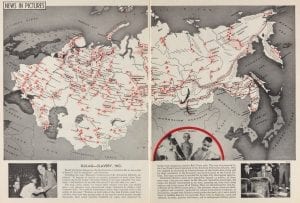This semester has been a wild ride. We have worked independently on individual projects, yes, but we have also engaged with a plethora of scholarly material, mostly in the digital humanities. On top of this, we have met in person and Skyped with several scholars who have helped us understand the digital humanities as a whole. They have also helped us tweak and improve our projects – this input and insight has been invaluable, and really shines as a positive takeaway from the class (in addition to being able to conduct research).
The opportunity to research music in the gulag has been such a wonderful experience, and I am so fortunate to be able to do something that I love – net necessarily for the sake of a grade, but for the chance to explore the topics that interest me greatly. While pursuing higher education and thinking about research questions and dissertations, I will remember this as the time during which I discovered a true passion for studying 20th c. Russian music. I never thought that studying something so specific and academic would be such a source of true joy for me – explaining this to non-scholars will prove interesting.
More important than my own story though, are the dozens of personal stories and excerpts from memoirs of the gulag victims. I have combed through them in an attempt to represent and illuminate a dark period of history through the eyes of these prisoners. Their stories, while sobering and grave, show the determination, spirit, and character of the Russian people that should not be ignored. Their stories have been buried for too long. They deserve to have their tales brought into the light, and I hope someday to be a part of the community of scholars who achieves this.
More specific to the class, I found that some of our readings and meetings with scholars assisted my work greatly. It was nice to read about digital humanities theory – like in Monmonier’s book How to Lie with Maps and in Toyosawa and Ethington’s article “Inscribing the Past: Depth as Narrative in Historical Spacetime.”1 I also liked reading about specific tactics to use when making maps, especially to show uncertainty, as in Bethany Nowviskie’s chapter “How to Play with Maps” in Cultural Mapping and the Digital Space, and Diana Sinton’s writing “Critical Spatial Thinking” from The International Encyclopedia of Geography.2
Our Skype “dates” and interactions with scholars in person were some of the most fruitful experiences I gained from the class. I appreciated speaking with Diana Sinton, Harmony Bench, Kate Elswit, and Todd Decker about the digital humanities in general. We addressed digital humanities activism, if maps should make arguments, and if maps as an immersive tool are valuable to the respective humanities fields that dip (or sometimes dive) into the digital humanities. While the Skype sessions were helpful, I believe that our session with Lincoln Mullen was the most helpful experience with an outside scholar of the whole semester. At that point, we were able to give him concrete maps that we’d created in order for him to provide us with feedback. His comments, immediately relevant and useful to our individual projects, were candid, respectful, and clear. Additionally, he is a professor at George Mason University, familiar with all the scholarship we’ve been reading, so he was able to communicate effectively with us undergraduates.
The final outputs of this semester appear similar to that of the CURI projects last summer, when we had all day every day to conduct and display our research – during the semester, when the DUR rivals with other classes for our time, I find this output impressive. We have all made multiple maps, and created sites on the Musical Geography webpage. My project page, Music in the Gulag, displays my maps, rationale, a glossary, bibliography, quotes, and other relevant sites – along with my conclusions from my maps (which are arguably less argumentative than my Ballets Russes maps). However, I believe that my intent was to make more immersive, narrative maps than quantitative maps that make arguments easier than those which are qualitative.
Overall, this course has been immensely helpful in teaching me about scholarly practice and the digital humanities. I’m so grateful to have worked with such a fine group of people, and I hope to carry what I’ve learned into future research endeavors.
1
Mark Monmonier, “Introduction” and “Maps for Political Propaganda,” in How to Lie with Maps (Chicago: University of Chicago Press, 1996), 1-4 and 87-112.
Philip Ethington and Nobuko Toyosawa, “Inscribing the Past: Depth as Narrative in Historical Spacetime” in Deep Maps and Spatial Narratives, ed. David J. Bodenhamer, John Corrigan, and Trevor M. Harris (Bloomington: Indiana University Press, 2015), 72-101.
2
Bethany Nowviskie, “How to Play with Maps,” in Cultural Mapping and the Digital Sphere: Place and Space, ed. Ruth Panofsky and Kathleen Kellett (Edmonton: University of Alberta Press, 2015), 107-127.\
Diana Sinton, “Critical Spatial Thinking,” The International Encyclopedia of Geography, ed. Douglas Richardson, Noel Castree, Michael F. Goodchild, Audrey Kobayashi, Weidong Liu, and Richard A. Marston (Hoboken: Wiley & Sons, 2017), 2-9.


You must be logged in to post a comment.